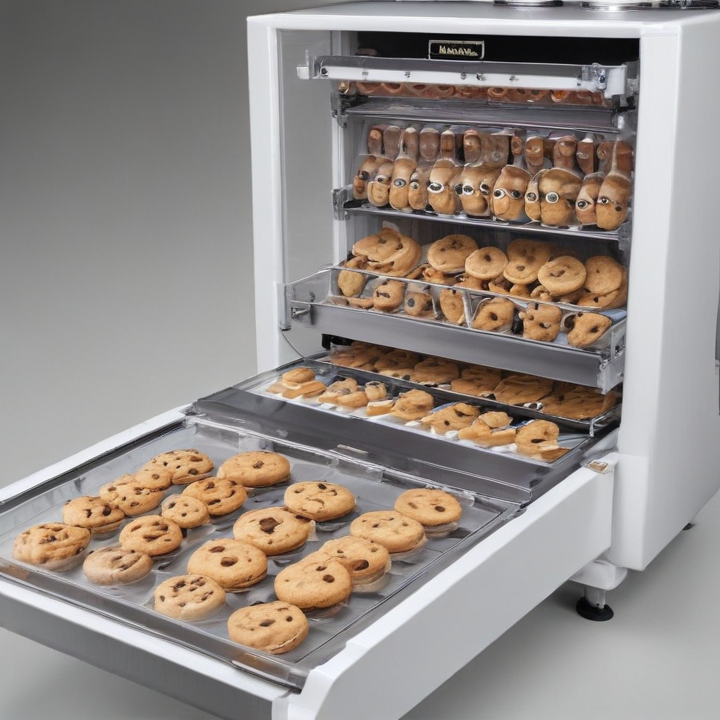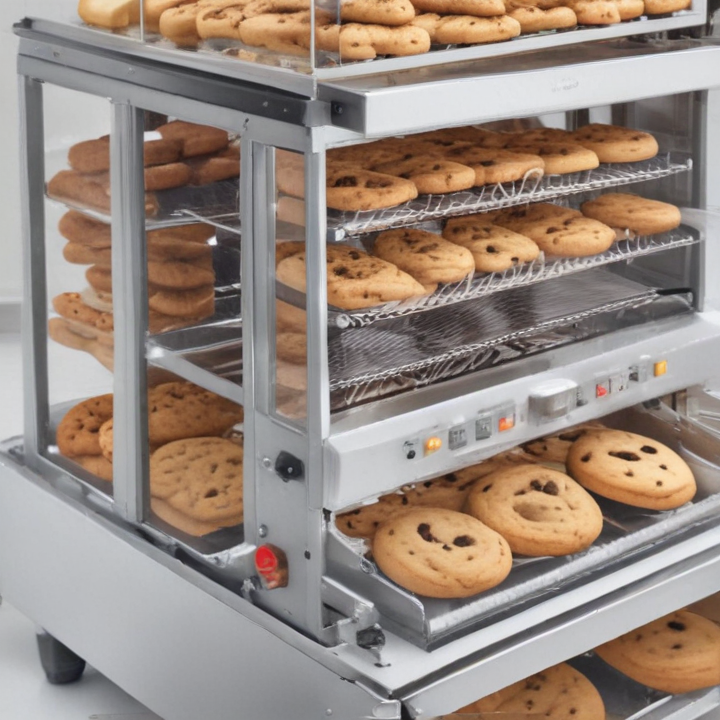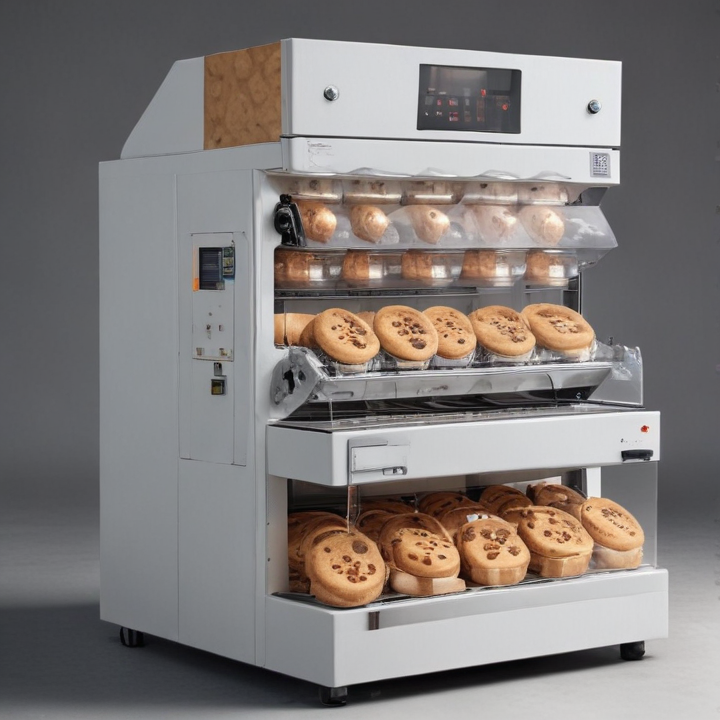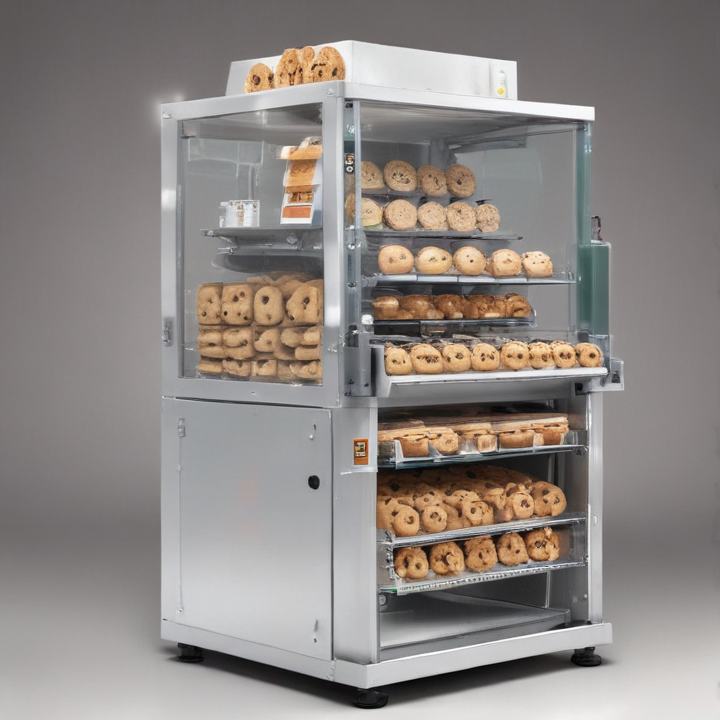A cookie packaging machine is designed to automate the wrapping and packaging process for cookies, ensuring efficiency, consistency, and hygiene. Here are the essential technical parameters to consider:
1. **Capacity**: Number of cookies packaged per minute (typically ranges from 50 to 300+ pieces per minute).
2. **Packaging Material**: Compatibility with various materials such as plastic films, aluminum foil, paper, etc.
3. **Film Roll Dimensions**:
– Width: Range that the machine can handle (commonly 50 mm to 500 mm).
– Diameter: Maximum roll diameter (usually around 300 mm to 450 mm).
4. **Cookie Dimensions**:
– Diameter/Size: Usually accommodates cookies with a diameter from 20 mm to 100 mm.
– Thickness/Height: Typically supports 5 mm to 30 mm.
5. **Sealing Type**: Heat sealing, cold sealing, or ultrasonic sealing.
6. **Power Supply**: Commonly 220V/50Hz or customized based on regional requirements.
7. **Power Consumption**: Measured in kW, typically ranging from 1.5 kW to 5 kW.
8. **Control System**:
– Type: PLC (Programmable Logic Controller) or microcontroller-based systems.
– Display: Touchscreen interface for easy operation.
9. **Servo Motors**: Number and type of servo motors used for precision and speed control.
10. **Feeding System**:
– Type: Automatic or semi-automatic.
– Conveyors: For the proper alignment and transfer of cookies.
11. **Machine Dimensions**: Length, width, and height (varies, but a typical machine might be around 4000 mm x 1000 mm x 1700 mm).
12. **Weight**: Usually between 800 kg to 1500 kg.
13. **Air Supply**: Required for pneumatic operations, typically around 0.6 MPa.
14. **Temperature Range**: Adjustable range for sealing jaws (commonly 0-300°C, depending on the material used).
15. **Noise Level**: Operating noise level, usually measured in dB (decibels).
These parameters ensure that the cookie packaging machine meets production requirements, maintains product quality, and operates efficiently.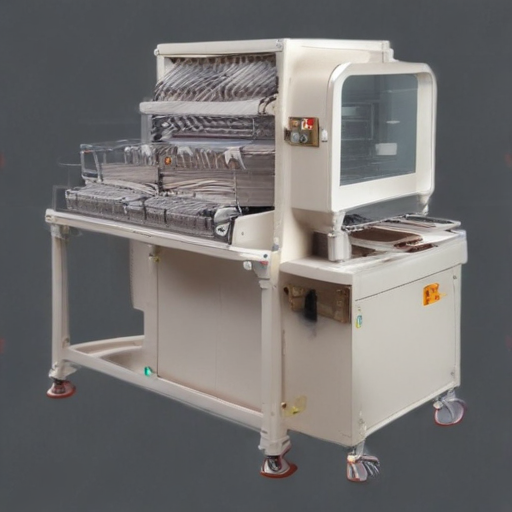
### Product Features: Cookie Packaging Machine
**1. **High-Speed Operation**
– Capable of packaging hundreds of cookies per minute, significantly enhancing productivity.
**2. Automated System**
– Features fully automated feeding, aligning, wrapping, and sealing systems to minimize manual intervention.
**3. **Versatile Packaging Options**
– Accommodates various packaging styles such as flow wraps, pouches, and custom shapes.
**4. User-Friendly Interface**
– Intuitive touchscreen controls, making it easy to adjust settings and monitor the machine’s performance.
**5. Precision and Consistency**
– Ensures uniform packaging, reducing waste and improving overall product presentation.
**6. **Adjustable for Different Cookie Types**
– Adaptable to handle cookies of various sizes, shapes, and types—whether soft, hard, or sandwich-style.
**7. **High-Quality Materials**
– Constructed with food-grade stainless steel and durable materials for longevity and compliance with health standards.
**8. Hygienic Design**
– Easy to clean with removable parts to maintain hygiene and adhere to food safety regulations.
**9. **Integrated Safety Features**
– Equipped with safety guards, emergency stop buttons, and fault detection systems to ensure operational safety.
**10. **Energy-Efficient**
– Designed to consume minimal energy, thereby reducing operational costs.
**11. **Customization and Flexibility**
– Customizable to include branding, labeling, and date printing directly on the packaging.
**12. **Space-Saving Design**
– Compact footprint suitable for various production environments, from small bakeries to large factories.
**13. **Low Maintenance Requirements**
– Engineered to require minimal maintenance, reducing downtime and operating costs.
**14. **Compatibility with Ancillary Equipment**
– Easily integrates with other production line equipment, such as ovens, cooling conveyors, and inspection systems.
**15. **Accurate Weighing and Filling**
– Built-in weighing mechanisms ensure each package meets the specified weight, adhering to quality control standards.
These features collectively make the cookie packaging machine a reliable, efficient, and versatile solution for the cookie packaging industry.
A cookie packaging machine is an indispensable asset in the food production and processing industry. These machines are designed to automate the packaging of cookies, thereby increasing efficiency, consistency, and shelf-life. Here are some key applications:
1. **Food Manufacturing Facilities:**
– **High-Speed Production Lines:** Used in large-scale cookie factories to package significant quantities quickly.
– **Quality Control:** Ensures consistent packaging, reducing human errors and maintaining uniformity.
2. **Bakeries:**
– **Local and Artisanal Bakeries:** Automate packaging processes, allowing small businesses to scale up their operations.
– **Custom Orders:** Flexibility to package custom orders efficiently, maintaining freshness and taste.
3. **Retail Packaging:**
– **Supermarkets and Convenience Stores:** Prepare cookies for retail shelves, ensuring tamper-evident and attractive packaging.
– **Private Label Branding:** Enables businesses to offer store-brand cookies in competitive packaging.
4. **E-commerce and Direct-to-Consumer Brands:**
– **Online Retail:** Package cookies safely for shipping, ensuring they arrive intact and fresh.
– **Subscription Boxes:** Consistent, attractive packaging for monthly cookie subscriptions and gift boxes.
5. **Event Catering and Corporate Gifts:**
– **Customized Packaging:** Create bespoke packaging for weddings, corporate events, and special occasions.
– **Bulk Orders:** Efficiently manage large-volume orders with custom packaging needs.
6. **Food Safety and Compliance:**
– **Hygienic Standards:** Ensure cookies are packed in a contamination-free environment, adhering to food safety regulations.
– **Extended Shelf-life:** Use of technology such as vacuum sealing or modified atmosphere packaging to prolong freshness.
7. **Research and Development Labs:**
– **Product Testing:** Facilitate packaging variants for taste tests and market research.
In summary, cookie packaging machines are versatile tools that enhance productivity, ensure product quality, and expand business opportunities across various sectors within the food industry.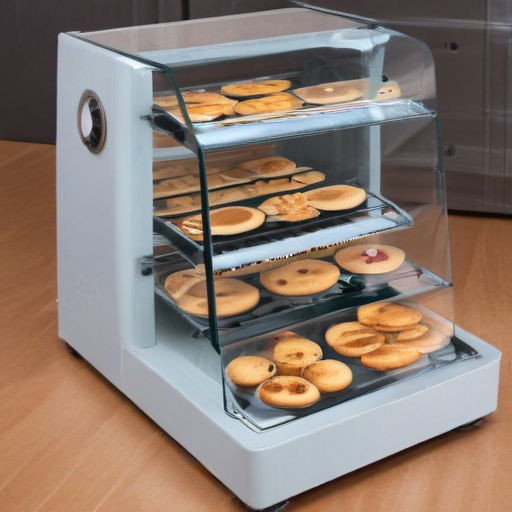
There are several types of cookie packaging machines designed to meet different production needs and packaging formats:
1. **Flow Wrapper Machines**:
– **Horizontal Flow Wrappers**: These machines wrap cookies individually or in groups with a continuous film flow, providing airtight seals. Ideal for high-speed operations.
– **Vertical Flow Wrappers**: Suitable for packing cookies into pouches, suitable for both small and large production capacities.
2. **Tray Sealer Machines**:
– **Manual Tray Sealers**: Used for low-volume production, requiring manual placement of trays and sealing film.
– **Automatic Tray Sealers**: Fully automated systems for high-speed, high-volume production, ensuring efficient packaging and sealing.
3. **Form, Fill and Seal Machines (FFS)**:
– **Vertical Form Fill Seal (VFFS)**: Efficient for packing cookies into stand-up pouches, pillow bags, or gusseted bags.
– **Horizontal Form Fill Seal (HFFS)**: Suitable for horizontal packaging formats, ideal for tray or carton style packaging.
4. **Blister Packaging Machines**:
– These machines pack cookies into thermoformed plastic blisters, often used for single-serve or multi-pack formats.
5. **Shrink Wrapping Machines**:
– **Manual Shrink Wrap Systems**: Suitable for smaller batches, involving manual placement and wrapping before shrinking.
– **Automatic Shrink Wrap Systems**: High-speed machines that wrap and shrink the film without manual intervention, ideal for bulk packaging.
6. **Biscuit Packaging Machine**:
– Specialized for different biscuit shapes and sizes, usually incorporates counting, feeding, and packaging functions into one machine.
7. **Cartoning Machines**:
– **Vertical Cartoners**: Place cookies into boxes from the top and close them, suitable for a variety of box styles.
– **Horizontal Cartoners**: Feed cookies horizontally into pre-formed cartons, often used for boxed cookie types.
8. **Multi-Function Packaging Machines**:
– Equipped with capabilities for weighing, filling, sealing, and labeling, providing comprehensive solutions for diverse packaging requirements.
By selecting the appropriate type of cookie packaging machine, manufacturers can optimize their production efficiency, packaging quality, and overall product presentation.
Certainly! Custom manufacturing options for cookie packaging machines allow you to tailor a machine to meet your specific production needs. Here are some key customizable features:
1. **Size and Capacity**: Machines can be designed to accommodate various sizes of cookies and packaging formats, from small snack packs to large family-sized packages. Adjustments in hopper and conveyor sizes can meet different production volumes.
2. **Materials and Durability**: Depending on your operational environment, you can choose materials like stainless steel for higher durability and easier cleaning, particularly crucial for food safety standards.
3. **Automation Level**: Opt for fully automated systems with features like robotic arms and sensor-based quality control, or semi-automated ones where manual intervention is minimal but necessary.
4. **Packaging Types**: Customize the machine to handle different types of packaging materials including plastic, cardboard, and eco-friendly options like biodegradable films.
5. **Speed and Efficiency**: Machines can be configured to operate at various speeds, balancing between production rate and precision. High-speed options with rapid changeover capabilities improve efficiency, while slower, more precise options ensure gentle handling of delicate cookies.
6. **Sealing Mechanisms**: Customize the sealing technology—heat sealing, ultrasonic sealing, or adhesive sealing—based on the packaging material and desired shelf life.
7. **Integration with Existing Systems**: Ensure compatibility with your current production line, including synchronization with upstream and downstream processes like baking and labeling.
8. **Smart Features**: Incorporate IoT and AI for predictive maintenance, real-time monitoring, and data analytics, helping to reduce downtime and optimize performance.
9. **Ergonomics and Safety**: Design machines with user-friendly interfaces, safety guards, and easy maintenance access to meet regulatory compliance and enhance operator comfort.
10. **Aesthetic Customizations**: Opt for specific colors and branding elements on the machine to align with your company’s brand identity.
Custom manufacturing options ensure your cookie packaging machine meets specific production requirements, boosts efficiency, and adheres to quality standards.
**Quality Control of Cookie Packaging Machine**
1. **Material Inspection**: Start with checking raw materials like stainless steel and electronic components for defects.
2. **Pre-Assembly Testing**: Inspect parts such as motors, sensors, and belts for proper functionality.
3. **Assembly Verification**: During assembly, ensure parts fit correctly and perform interim tests.
4. **Calibration**: Calibrate sensors, controls, and measuring devices according to specifications.
5. **Functional Testing**: Post-assembly, conduct a full system run to check packaging speed, accuracy, and consistency.
6. **Safety Checks**: Verify all safety features, such as emergency stops and guards, are operational.
7. **Final Inspection**: Perform a comprehensive review of machine operation, including software, mechanical, and electrical systems.
8. **Documentation Review**: Ensure all quality control records and compliance certifications are complete and accurate.
**Manufacturing Process of Cookie Packaging Machine**
1. **Design and Planning**: Engineers create detailed designs, considering the specifications of cookie packaging requirements.
2. **Material Sourcing**: Procurement team acquires high-quality materials and components that meet industry standards.
3. **Machining**: Use CNC machines to fabricate parts with precision.
4. **Pre-Assembly**: Sub-assemblies such as the frame, conveyor system, and sealing mechanisms are pre-assembled.
5. **Main Assembly**: Combine all sub-assemblies into the main framework; technicians follow blueprints to integrate mechanical and electrical components.
6. **Wiring and Control Systems**: Install and connect wiring and control systems, ensuring they comply with electrical standards.
7. **Calibration and Testing**: Calibrate each machine module, followed by rigorous functional tests to ensure cohesiveness.
8. **Debugging**: Identify and rectify any issues that arise during testing.
9. **Quality Inspection**: Final machine inspection to ensure it meets all specifications and quality standards.
10. **Packaging and Dispatch**: Finally, the machine is carefully packed and dispatched to the customer.
This streamlined approach ensures that the cookie packaging machine is both high-quality and reliable, meeting all customer and regulatory standards.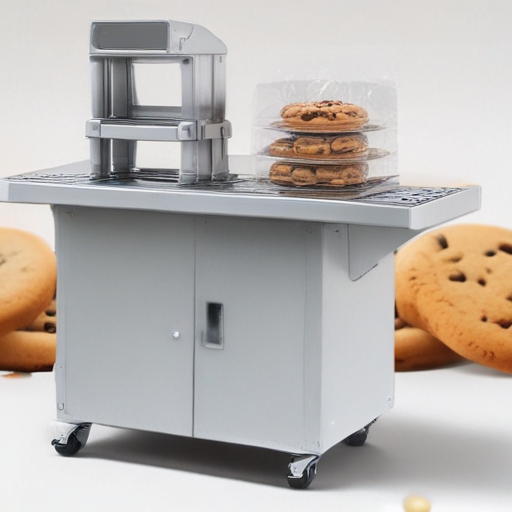
Using a cookie packaging machine involves several key steps to ensure efficient and proper operation. Below is a concise guide on how to use such a machine:
### 1. **Preparation:**
– **Read the Manual:** Before operating the machine, thoroughly read the user manual provided by the manufacturer.
– **Inspect the Machine:** Ensure all parts are assembled correctly and check for any damage or wear.
– **Clean the Area:** Make sure the working area is clean to avoid contamination.
### 2. **Setup:**
– **Load Packaging Material:** Insert the appropriate packaging film or bags into the machine. Make sure it is aligned correctly.
– **Adjust Machine Settings:** Set the desired parameters such as temperature, size, and sealing time according to the cookie type and packaging material.
### 3. **Operation:**
– **Power On:** Switch on the machine and allow it to warm up if necessary.
– **Load Cookies:** Place the cookies on the conveyor belt or feeding tray. Make sure they are spaced evenly.
– **Start Packaging:** Initiate the packaging process by pressing the start button. The machine will automatically wrap, seal, and cut the packages.
### 4. **Monitoring:**
– **Supervise:** Continuously monitor the packaging process. Ensure the machine is operating smoothly and the cookies are being packaged correctly.
– **Adjust Settings:** If needed, fine-tune the settings to optimize performance.
### 5. **Shut Down and Maintenance:**
– **Turn Off:** Once packaging is complete, turn off the machine and unplug it.
– **Clean:** Clean the machine according to the manufacturer’s instructions to maintain hygiene and prolong its lifespan.
– **Inspect:** Regularly inspect and maintain the machine, checking for any parts that may need repair or replacement.
By following these steps, you can effectively use a cookie packaging machine to enhance productivity and ensure your cookies are packaged efficiently and hygienically.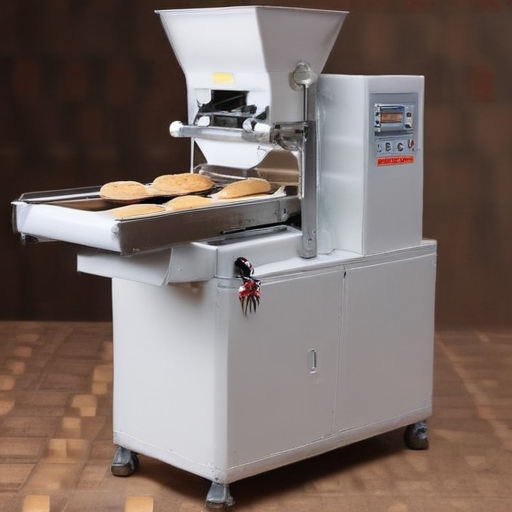
A cookie packaging machine is specialized equipment designed to automate the packaging process for cookies. Below are the properties and terms commonly associated with such machines:
### Properties:
1. **Automation**: Capable of fully automated or semi-automated operation to enhance efficiency.
2. **Speed**: Variable speed settings to cater to different production requirements, often measured in cookies per minute (CPM).
3. **Versatility**: Ability to handle various cookie shapes and sizes, including round, square, and customized designs.
4. **Material Compatibility**: Works with different packaging materials, such as plastic films, aluminum foils, and paper.
5. **Precision**: High accuracy in cookie placement and sealing to minimize waste and ensure consistent packaging.
6. **Hygiene**: Designed with food-grade materials and easy-to-clean components to meet sanitation standards.
7. **User Interface**: Equipped with an intuitive control panel, often featuring a touchscreen for ease of use.
8. **Safety Features**: Built with safety guards and emergency stop buttons to prevent accidents.
9. **Modularity**: Expandable options for add-ons like labeling, barcode printing, and date coding.
10. **Energy Efficiency**: Low power consumption for sustainable operation.
### Terms:
1. **Form-Fill-Seal (FFS)**: A type of packaging process that forms the package, fills it with the product, and seals it in one continuous operation.
2. **Flow Wrapping**: A horizontal packaging process where cookies are wrapped individually or in groups in a continuous film.
3. **Vertical Form Fill Seal (VFFS)**: A vertical packaging process where products are dropped into a forming tube, sealed, and cut by the machine.
4. **Doypack**: A type of stand-up pouch that is commonly used for packaging multiple cookies.
5. **Thermoforming**: The process of forming plastic sheets into package shapes, often used for cookie trays and blister packs.
6. **Shrink Wrapping**: Creases a heat-sensitive film around the product; film shrinks tightly to the product when heated.
7. **Primary Packaging**: The first layer of packaging that directly contacts the cookies.
8. **Secondary Packaging**: Additional layers for group packaging, such as boxes or cartons, for easier distribution and handling.
9. **MAP (Modified Atmosphere Packaging)**: Packaging that alters the oxygen, carbon dioxide, and nitrogen levels to extend shelf life.
10. **Quality Control**: Integrated systems like vision inspection and check-weighers to ensure only correctly packed products progress.
The evolution of cookie packaging machines has been a journey marked by technological advancements and increasing automation to enhance efficiency and product quality. Here’s a concise timeline highlighting key developments:
1. **Early 20th Century – Manual Packaging:** Initially, cookies were packaged manually, often in wax paper or simple cardboard boxes. Labor-intensive, this method lacked uniformity and efficiency.
2. **1930s – Semi-Automatic Machines:** The introduction of semi-automatic machines began to streamline the packaging process. These machines could partially automate tasks such as folding and sealing, though manual labor was still significant.
3. **1950s – Fully Automatic Machines:** With advancements in engineering, fully automatic cookie packaging machines were developed. These machines handled entire packaging processes, from placing cookies in wrappers to sealing and boxing, significantly improving speed and consistency.
4. **1970s – Horizontal Flow Wrappers:** The adoption of horizontal flow wrappers became widespread. These machines moved cookies horizontally through a protective film that was cut and sealed, preserving freshness and extending shelf life.
5. **1980s – Integration of Control Systems:** The integration of programmable logic controllers (PLCs) enabled better control and precision. This allowed for adjustments in packaging parameters, reducing human error and increasing automation.
6. **1990s – High-Speed Machines:** The demand for higher production capacities led to the development of high-speed packaging machines capable of handling hundreds of cookies per minute, incorporating robotic systems for even greater efficiency.
7. **2000s – Advanced Robotics and AI:** The 21st century introduced advanced robotics and artificial intelligence (AI) to cookie packaging. These technologies enabled real-time monitoring, predictive maintenance, and improved flexibility to handle various cookie shapes and sizes.
8. **2010s – Sustainable Packaging:** The focus shifted towards environmentally friendly packaging solutions. Machines evolved to accommodate biodegradable or recyclable materials, aligning with global sustainability trends.
9. **2020s – Industry 4.0 Integration:** Today’s cookie packaging machines integrate Industry 4.0 capabilities, including IoT sensors, data analytics, and remote monitoring, optimizing the entire manufacturing process and ensuring the utmost efficiency and minimal downtime.
This evolution reflects ongoing innovation aimed at meeting consumer demands and regulatory requirements while pushing towards greater sustainability and efficiency.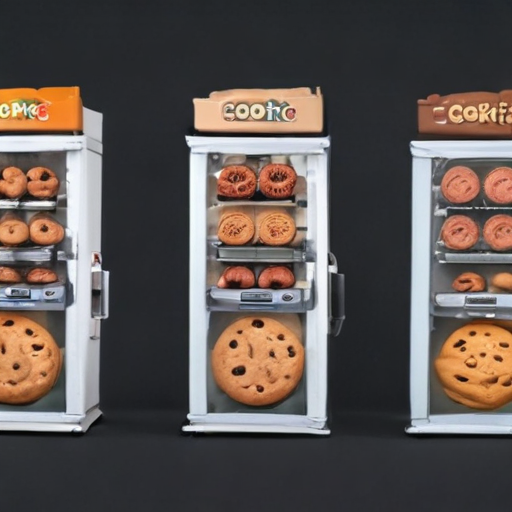
Selecting a reliable cookie packaging machine involves several key considerations to ensure efficiency, quality, and suitability for your specific needs. Here are some essential tips:
1. **Determine Your Needs**:
– **Production Volume**: Assess your daily, weekly, or monthly production needs to choose a machine with the appropriate capacity.
– **Package Type**: Decide on the type of packaging (e.g., pillow bags, stand-up pouches, trays) that aligns with your branding and product protection requirements.
2. **Machine Features**:
– **Automation Level**: Choose between manual, semi-automatic, or fully automatic machines based on your labor availability and efficiency goals.
– **Flexibility**: Opt for machines that can handle various cookie sizes and packaging styles if you plan to package different products.
– **Precision and Speed**: Ensure the machine offers accurate portion control and high-speed operation to maintain production efficiency.
3. **Quality and Durability**:
– **Build Material**: Look for machines made from high-quality, food-grade materials that ensure longevity and hygiene standards.
– **Brand Reputation**: Research well-known manufacturers and read customer reviews to gauge reliability.
– **Warranty and Support**: Consider suppliers that offer robust warranties and reliable customer support for troubleshooting and maintenance.
4. **Compliance and Safety**:
– Ensure the machine meets all relevant health and safety standards, such as FDA or CE certifications, to guarantee safe and compliant operation.
5. **Budget Considerations**:
– Balance cost with features and durability. Investing in a slightly more expensive but well-built machine can save costs in the long run due to reduced repairs and longer lifespan.
6. **Trials and Demos**:
– Whenever possible, test the machine or request a demonstration to observe its performance in real-time.
By carefully evaluating these factors, you will be able to select a reliable cookie packaging machine that meets your production needs and ensures product quality.
Certainly! Below is a concise FAQ for a Cookie Packaging Machine, kept under 300 words:
**Cookie Packaging Machine FAQ**
1. **What is a cookie packaging machine?**
– A cookie packaging machine automates the process of wrapping, sealing, and labeling cookies for shipping and retail.
2. **What types of cookies can it package?**
– These machines can handle a variety of cookies including hard, soft, sandwich, and filled cookies.
3. **What packaging formats are available?**
– Common formats include flow wraps, pouches, trays, and boxes.
4. **Is it easy to operate?**
– Most models are user-friendly with touch screens and programmable settings. Basic training is usually sufficient.
5. **What are the key features to look for?**
– Look for customizable settings, high-speed operation, versatility in handling different packaging materials, and machine durability.
6. **How fast does it package cookies?**
– Speeds vary, but many machines can package between 100 to 300 cookies per minute.
7. **Can it work with different types of packaging materials?**
– Yes, most machines can handle a range of materials like plastic, foil, and paper.
8. **What sizes can it handle?**
– Machines come adjustable to handle various cookie sizes and shapes.
9. **How much does it cost?**
– Prices can range from a few thousand to several hundred thousand dollars, depending on capabilities and brand.
10. **Is maintenance required?**
– Regular maintenance is essential for optimal performance. Follow the manufacturer’s guidelines for cleaning and part replacement.
11. **Can it be integrated into an existing production line?**
– Yes, many machines are designed to be compatible with upstream and downstream processes in a production line.
12. **What about hygiene standards?**
– High-quality machines adhere to food safety standards, featuring stainless steel components and easy-to-clean designs.
13. **What is the warranty period?**
– Warranties typically range from one to three years, based on the manufacturer.
14. **What after-sales service is available?**
– Services often include technical support, replacement parts, and periodic maintenance checks.
15. **Can it be customized for specific requirements?**
– Many manufacturers offer customization options to meet unique production needs.
1. **What types of cookie packaging machines are available?**
Cookie packaging machines can be broadly categorized into flow wrap machines, vertical form fill seal (VFFS) machines, and rotary pouch packing machines. Each type is designed for different packaging needs and production speeds.
2. **What materials can these machines handle?**
Most cookie packaging machines are versatile and can handle a variety of materials including laminated films, aluminum foils, and cardboard. The choice depends on the product’s preservation needs and marketing requirements.
3. **Are these machines customizable?**
Yes, many manufacturers offer customization options to meet your specific packaging requirements, such as different sizes, shapes, and sealing types. Customization can also include branding elements like logos and colors.
4. **What is the usual production capacity?**
Production capacity varies by machine type and model. Entry-level machines might handle 20-50 packs per minute, while advanced models can package up to 150 packs per minute or more.
5. **What is the typical lead time for delivery?**
The lead time can range from 4 to 12 weeks depending on the complexity of the machine and the manufacturer’s current order volume. Customizations may extend this timeline.
6. **What is the cost range?**
Prices can range from a few thousand dollars for basic models to over $100,000 for high-end, fully automated systems. The cost depends on factors such as capacity, level of automation, and customization requirements.
7. **What kind of maintenance is required?**
Regular maintenance is crucial for optimal performance. This includes routine checks, lubrication of moving parts, and occasional replacement of wear-and-tear components. Many suppliers offer maintenance contracts.
8. **Can these machines integrate with existing production lines?**
Yes, most modern cookie packaging machines are designed for easy integration with other production line equipment such as mixers, ovens, and conveyors, simplifying the production process.
9. **What kind of after-sales support is provided?**
Reputable suppliers usually offer comprehensive after-sales support, including installation, training, and 24/7 technical assistance. Some may also provide spare parts and maintenance services.
10. **Is there a warranty?**
Warranty periods vary, but many manufacturers offer at least a one-year warranty covering parts and labor. Extended warranties may be available at an additional cost.
These FAQs should help you in sourcing the right cookie packaging machine from China, facilitating a smoother procurement process.

